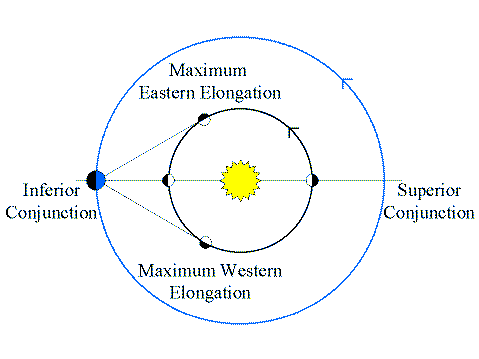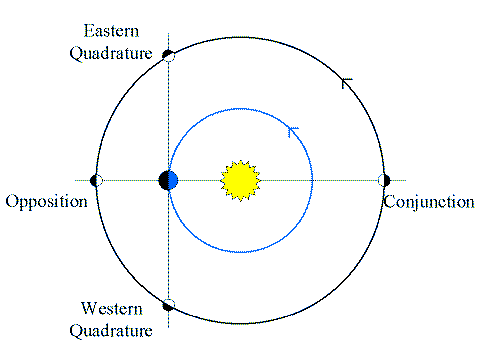Lecture 12: The Wanderers
Key Ideas
The Planets:
- "Wandering stars" that follow complex paths
near the Ecliptic.
Planetary Configurations:
- Inferior Planets
- Superior Planets
- Conjunction & Opposition
Retrograde Motion
The Naked-Eye Sky
Celestial objects visible to the naked-eye include
- Sun:
- Bright disk ~1/2º across
- Moon:
- Pale disk ~1/2º across that goes through monthly phases.
- Stars:
- Pinpoints of light that appear fixed relative to each
other on the Celestial Sphere.
- Planets: (Greek: planetai = wanderers)
- Points of light that move relative to the
"fixed" stars.
- Stay within a few degrees of the Ecliptic
- Follow complex paths that take between 88d
(Mercury) and 30y (Saturn) to complete a
circuit through the Zodiac.
Five Classical Planets:
- Mercury, Venus, Mars, Jupiter, & Saturn
Inferior & Superior Planets
Early astronomers recognized that the 5 classical planets could be
divided into two groups:
Inferior Planets: Mercury & Venus
- Appear to follow the Sun across the sky.
- <28º for Mercury, and <47º for Venus.
Superior Planets: Mars, Jupiter, & Saturn
- All move along the Ecliptic on paths seemingly
independent of the motions of the Sun.
- All can appear in the sky any time (e.g., around midnight)
Inferior Planet Configurations

(Click on the image to view at full scale [Size:
9Kb])
Inferior Conjunction:
- Planet is between the Earth and the Sun.
Superior Conjunction:
- Planet on the other side of the Sun from Earth.
During either conjunction, the inferior planet appears to rise and set
with the Sun.
Maximum Eastern Elongation:
- Planet is at its furthest East of the Sun as seen
from the Earth (28º for Mercury, 47º for Venus)
- Rises & sets after the Sun ("evening
star")
Maximum Western Elongation:
- Planet is at its furthest West of the Sun as seen
from the Earth (same angles as Eastern Elongation).
- Rises & sets before the Sun ("morning
star")
Superior Planet Configurations

(Click on the image to view at full scale [Size:
9Kb])
Opposition:
- Planet is opposite the Sun in the sky.
- Rises as the Sun sets
- Highest in the sky at midnight.
Conjunction:
- Planet is on the same side of the sky as the Sun.
- Rises with the Sun
- The planet does not appear in the the night sky.
Eastern Quadrature:
- Planet at right angles to the Earth-Sun line.
- Planet rises at noon, sets at midnight.
Western Quadrature:
- Planet at right angles to the Earth-Sun line.
- Planet rises at midnight, sets at noon.
Retrograde Motion
In general, the planets move eastward relative to the
"fixed" stars.
- Called "Direct Motion".
- Motion is non-uniform (not at the same speed).
Sometimes, however, the planets appear to
- Slow down & stop!
- Start moving westward, or RETROGRADE,
- Slow down & stop again,
- Resume moving eastward again.
[Click Here to see an image (16Kb) of the
retrograde motions of Mars during 1994/95 when it made a particularly
characteristic loop. A 688Kb QuickTime movie
shows this figure in motion (beware! it is large!)]
Apparent retrograde motion is observed in all planets.
Inferior Planets (Mercury & Venus):
- Undergo retrograde motion at around the time of inferior
conjunction.
Superior Planets (Mars, Jupiter, & Saturn):
- Undergo retrograde motion at around the time of opposition.
For both, the paths are complex, making loops and S-curves due to an
additional North and south wandering about the Ecliptic.
[Click Here to see an montage (18Kb) of the
recent (1998-2000) retrograde motions of Mercury, Venus, Mars, Jupiter,
and Saturn. Note that Jupiter & Saturn, currently visible after
sunset high in the Eastern sky, are just now (Jan 18) ending a period of
retrograde motion that started back in October of last year.]
Who Ordered That?
Unlike all of the other motions we've seen thus far, planetary
motions are dauntingly complex.
The struggle to understand these motions took nearly 3000 years:
- The motions are subtle and defy poetic or metaphorical
description.
- Their complexity similarly defies simple geometric
description.
Explaining planetary motions poses a formidable challenge to any theory
of the heavens.
A Question of Approach
How do we explain the motions of the planets?
Two approaches have been taken:
Phenomenological Description
- Find a way to compute the motions without worrying about the
details of why they work this way.
- Goal is to "preserve appearances" (i.e., make reliable predictions)
Physical Description
- Discover the underlying physical principles behind
the planetary motions (i.e., ask "why" they move).
- Predictions of the motions should then follow from first principles
From Myth to Science
Any satisfactory theory of planetary motions had to have the
following characteristics:
Internal Consistency:
- Must follow the same basic rules, no special cases or
special pleading allowed.
Predictive Power:
- Must provide measurably accurate predictions of future
behavior.
The effort to come up with a self-consistent, predictive theory of
planetary motions marks the true birth of science.
Return to [
Unit 2 Index
|
Astronomy 161 Main Page
]
Updated: 2006 September 23
Copyright © Richard W. Pogge, All Rights
Reserved.

